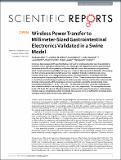Wireless Power Transfer to Millimeter-Sized Gastrointestinal Electronics Validated in a Swine Model
Author(s)
O?Brien, Jonathan M.; Traverso, Giovanni; Abid, Abubakar; Bensel, Taylor A; Cleveland, Cody; Booth, Lucas; Smith, Brian R.; Langer, Robert S; ... Show more Show less
DownloadWireless power transfer.pdf (607.1Kb)
PUBLISHER_CC
Publisher with Creative Commons License
Creative Commons Attribution
Terms of use
Metadata
Show full item recordAbstract
Electronic devices placed in the gastrointestinal (GI) tract for prolonged periods have the potential to transform clinical evaluation and treatment. One challenge to the deployment of such gastroresident electronics is the difficulty in powering millimeter-sized electronics devices without using batteries, which compromise biocompatibility and long-term residence. We examined the feasibility of leveraging mid-field wireless powering to transfer power from outside of the body to electronics at various locations along the GI tract. Using simulations and ex vivo measurements, we designed mid-field antennas capable of operating efficiently in tissue at 1.2 GHz. These antennas were then characterized in vivo in five anesthetized pigs, by placing one antenna outside the body, and the other antenna inside the body endoscopically, at the esophagus, stomach, and colon. Across the animals tested, mean transmission efficiencies of −41.2, −36.1, and −34.6 dB were achieved in vivo while coupling power from outside the body to the esophagus, stomach, and colon, respectively. This corresponds to power levels of 37.5 μW, 123 μW and 173 μW received by antennas in the respective locations, while keeping radiation exposure levels below safety thresholds. These power levels are sufficient to wirelessly power a range of medical devices from outside of the body.
Date issued
2017-04Department
Massachusetts Institute of Technology. Department of Biological Engineering; Massachusetts Institute of Technology. Department of Chemical Engineering; Massachusetts Institute of Technology. Department of Electrical Engineering and Computer Science; Massachusetts Institute of Technology. Department of Mechanical EngineeringJournal
Scientific Reports
Publisher
Nature Publishing Group
Citation
Abid, Abubakar, Jonathan M. O’Brien, Taylor Bensel, Cody Cleveland, Lucas Booth, Brian R. Smith, Robert Langer, and Giovanni Traverso. “Wireless Power Transfer to Millimeter-Sized Gastrointestinal Electronics Validated in a Swine Model.” Scientific Reports 7 (April 27, 2017).
Version: Final published version
ISSN
2045-2322